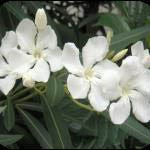Danger in beauty: These shrubs have gorgeous flowers. But they're toxic. What to know

Among our most enigmatic shrubs is oleander (Nerium oleander). Though not uncommon here, it’s certainly not present in numbers that its beautiful blossoms would warrant.
The reason, of course, is oleander’s reputation as a toxic plant. Indeed, lurid tales abound, including a story that was already old when retold by David Fairchild in his 1930 book "Exploring for Plants." The account – probably apocryphal – tells of a family that died while picnicking because they used oleander stems as meat skewers. More credence, however, should be given to the belief that breathing smoke from burning oleander foliage can be harmful. That’s why oleander trimmings should be composted or discarded.
The preceding paragraph shows that this 10- to 20-foot plant, though toxic, is not to be feared: The foliage is so distasteful that it’s extremely unlikely anyone is going to chew enough leaves to be sickened.
Blue porterweed:This native perennial blooms year-round and is loved by butterflies and other pollinators
In nature, oleander ranges from the Mediterranean region all the way to Southern China. While there’s just one species, the number of varieties available is mind-boggling, including kinds with double flowers as well as an attractive pink-flowered dwarf. Blossom hues can be white, yellow, pink, red and bicolored.
In Florida, oleander demands full sun and deep, sandy soil. If plants become leggy, don’t hesitate to cut them back hard.
As for damage caused by the distinctively orange-and-black caterpillars, it appears that parasitic wasps and flies are keeping them in check. If your oleanders are being defoliated by caterpillars, spray – on a calm day – with Thuricide. Propagate with warm-season cuttings.
Higher on the toxicity scale are angel’s trumpet shrubs, often seen as hybrids of 14 Tropical American species of Brugmansia.
All parts of these plants contain scopolamine and atropine, and – according to an IFAS bulletin – children have been poisoned by eating the fruit and sucking nectar from the large, pendulous flowers.
Also in danger are the foolish folks who attempt to exploit the hallucinogenic properties of angel’s trumpet foliage and fruit: even a bit too much could prove lethal.
In the landscape, angel’s trumpet often wilts during hot midsummer days if planted in full sun. The best locations are in bright, filtered light. For most varieties – which range from I to 12 feet tall – considerable space is required.
If you’re wondering about devil’s trumpet plants (Datura species and varieties), they’re just as poisonous as angel’s trumpets. That includes our native jimson weed. Incidentally, it’s easy to distinguish between Brugmansia and Datura. Angel’s trumpets hang downward, while devil’s trumpets look upward.
Plant to ponder: Polyscias paniculata

Polyscias paniculata, usually seen in variegated form, is often listed as variegated Ming aralia. Native to islands – such as the Seychelles – in the Indian Ocean, this variable plant makes an attractive houseplant for bright, indirect sites. Propagate by cuttings. Plants are available online.